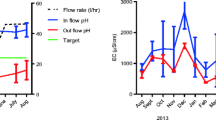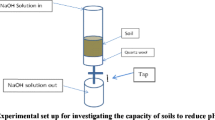Abstract
In Northern Ireland, phosphorus enrichment of lakes due to agriculture is a significant problem. Heavy metal exports from landfill sites, often located on water-logged land, are also of concern. Locally available laterite, a low grade bauxite which is rich in iron and aluminium, is used in acid solution with subsequent precipitation to remove phosphorus and heavy metals at several sewage treatment works. Constructed wetlands offer an attractive alternative to conventional waste water treatment in certain circumstances but removal of phosphorus is strongly dependent on the bed medium. Calcium-, iron- and aluminium-rich solid media are recommended. A brief introduction to the use and cost-effectiveness of constructed wetlands (CWs) in treating a range of effluents is given. This study, using both laboratory tests and pilot-scale constructed wetlands, reports the effectiveness of granular laterite in removing phosphorus and heavy metals from landfill leachate. Initial laboratory studies have shown that laterite is capable of 99% removal of phosphorus from solution. A pilot-scale experimental CW containing laterite achieved 96% removal of phosphorus. This removal is much greater than that reported in other systems. Initial removals of aluminium and iron by pilot-scale CWs have been up to 85% and 98% respectively. Percolating columns of laterite reduced Cd, Cr and Pb to undetectable concentrations. Possible application of this low cost, low technology, visually unobtrusive yet efficient system to rural areas with dispersed point sources of pollution is discussed.
Similar content being viewed by others
References
Armstrong, W., J. Armstrong & P. M. Beckett, 1990. Measurement and modelling of oxygen release from roots of Phragmites australis. In P. F. Cooper & B. C. Findlater (eds), Constructed wetlands in water pollution control. Pergamon Press, Oxford: 41–51.
Brix, H., 1993. Macrophyte-mediated oxygen transfer in wetlands: transport mechanisms and rates. In G. A. Moshiri (ed.), Constructed wetlands for water quality improvement. Lewis, Boca Raton: 391–398.
Cooper, P. F., 1990. European design and operations guidelines for reed bedtreatment systems. EC/EWPCA Emergent Hydrophyte Treatment Systems Expert Contact Group. WRC Medmenham UK.
Cooper, P. F., J. A. Hobson & C. Findlater, 1990. The use of reed bed treatment systems in the U.K. Wat.Sci. & Tech. 22: 57–64.
Delgado, M., M. Bigeriego & E. Guardiola, 1993. Uptake of Zn, Cr and Cd by water hyacinths. War. Res. 27: 269–272.
Denny, P., 1980. Solute movement in submerged angiosperms. Biol. Rev. 55: 65–92.
Eyles, V. A., 1952. The composition and origin of the Antrim laterites and bauxites. Government of Northern Ireland, Memoirs of the Geological Survey. HMSO, Belfast, 90 pp.
Gray, A. V., 1985. Removal of phosphate at sewage treatment works and the implications on phosphate loadings into Lough Neagh. J. Inst. Wat. Eng. Sci. 39: 137–154.
Green, M. B. & J. Upton, 1993. Reed bed treatment for small communities: UK experience. In G. A. Moshiri (ed.), Constructed wetlands for water quality improvement. Lewis, Boca Raton: 517–52.
Green, M. B. & J. Upton, 1994. Constructed reed beds: a costeffective way to polish wastewater effluents for small communities. Wat. Envir. Res. 66: 188–192.
Higgins, M. J., C. A. Rock, R. Bouchard & Wengreynek., 1993. Controlling agricultural runoff by use of constructed wetlands. In G. A. Moshiri (ed.), Constructed wetlands for water quality improvement. Lewis, Boca Raton: 359–367.
HMSO, 1978a. Manganese in raw and potable waters by spectrophotometry (using formaldoxime). In Methods for the examination of waters and associated materials. HMSO, London. ISBN 011 751328 8
HMSO, 1978b. Iron in raw and potable waters by spectrophotometry (using 2–4–6 tripyridyl-135-triazine). In Methods for the examination of waters and associated materials. HMSO, London. ISBN 011 751327
HMSO, 1980. Aluminium in raw and potable waters by spectrophotometry (using pyrocatechol violet). In Methods for the examination of waters and associated materials. HMSO, London. ISBN 0117 514640
Howard-Williams, C., 1985. Cycling and retention of nitrogen and phosphorus in wetlands: a theoretical and applied perspective. Freshwat. Biol. 15: 391–431.
Lawson, G. J., 1985. Cultivating reeds (Phragmites australis) for root zone treatment of sewage. Contract report to the Water Research Centre. ITE Project 965 Cumbria, UK.
Lienard, A., C. Boutin & D. Esser, 1990. Domestic waste-water treatment with emergent hydrophyte beds in France. In P. F. Cooper & B. P. Findlater (eds), Constructed wetlands in water pollution control. Pergamon Press, Oxford, UK: 183–192.
Martin, C. D., G. A. Moshiri & C. Miller, 1991. Mitigation of landfill-generated leachate incorporating in-series constructed wetlands in a closed loop design. Abstract G.6. In Constructed wetlands for water quality improvement Symposium. Pensacola, Florida.
Moshiri, G. A., 1993 (ed.). Constructed wetlands for water quality improvement. Lewis, Boca Raton: 632 pp.
Murphy, J. & J. P. Riley, 1958. A single-solution method for the determination of phosphorus in sea water. J. Mar. Biol. Ass. UK, 37: 9–14.
Murphy, J. & J. P. Riley, 1962. A modified single-solution method for the determination of phosphorus in natural waters. Analytica Chimica Acta, 27: 31–36.
Ogden, M. H., 1993. The treatment of septage using natural systems. In G. A. Moshiri (ed.), Constructed wetlands for water quality improvement. Lewis, Boca Raton: 525–533.
Schierup, H. H. & V. J. Larsen, 1981. Macrophyte cycling of zinc, copper, lead and cadmium in the littoral zone of a polluted and a non-polluted lake: I. Availability, uptake and translocation of heavy metals in Phragmites australis (CAV) Trin. Aquat. Bot. 11: 197–210.
Surface, J. M., J. H. Peverly, T. S. Steenhius & W. E. Stanford, 1993. Effect of season, substrate composition, and plant growth on landfill leachate treatment in a constructed wetland. In G. A. Moshiri (ed.), Constructed wetlands for water quality improvement. Lewis, Boca Raton: 461–472.
Vymazal, J., 1993. Constructed wetlands for wastewater treatment in Czechoslovakia: state of the art. In G. A. Moshiri (ed.), Constructed wetlands for water quality improvement. Lewis, Boca Raton: 255–260.
Wood, R. B & C. F. McAtamney, 1994. The use of macrophytes in bioremediation. Biotechnol. Adv. 12: 653–662.
Author information
Authors and Affiliations
Rights and permissions
About this article
Cite this article
Wood, R.B., McAtamney, C.F. Constructed wetlands for waste water treatment: the use of laterite in the bed medium in phosphorus and heavy metal removal. Hydrobiologia 340, 323–331 (1996). https://doi.org/10.1007/BF00012776
Issue Date:
DOI: https://doi.org/10.1007/BF00012776




